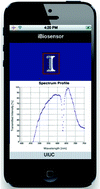This month sees the following articles in Lab on a Chip that are in the top ten most accessed:
Microfluidically-unified cell culture, sample preparation, imaging and flow cytometry for measurement of cell signaling pathways with single cell resolution
Meiye Wu, Thomas D. Perroud, Nimisha Srivastava, Catherine S. Branda, Kenneth L. Sale, Bryan D. Carson, Kamlesh D. Patel, Steven S. Branda and Anup K. Singh
Lab Chip, 2012, 12, 2823-2831
DOI: 10.1039/C2LC40344G
Blood separation on microfluidic paper-based analytical devices
Temsiri Songjaroen, Wijitar Dungchai, Orawon Chailapakul, Charles S. Henry and Wanida Laiwattanapaisal
Lab Chip, 2012, 12, 3392-3398
DOI: 10.1039/C2LC21299D
Microfluidic electronics
Shi Cheng and Zhigang Wu
Lab Chip, 2012, 12, 2782-2791
DOI: 10.1039/C2LC21176A
In vitro formation and characterization of a perfusable three-dimensional tubular capillary network in microfluidic devices
Ju Hun Yeon, Hyun Ryul Ryu, Minhwan Chung, Qing Ping Hu and Noo Li Jeon
Lab Chip, 2012, 12, 2815-2822
DOI: 10.1039/C2LC40131B
High throughput method for prototyping three-dimensional, paper-based microfluidic devices
Gregory G. Lewis, Matthew J. DiTucci, Matthew S. Baker and Scott T. Phillips
Lab Chip, 2012, 12, 2630-2633
DOI: 10.1039/C2LC40331E
Commercialization of microfluidic point-of-care diagnostic devices
Curtis D. Chin, Vincent Linder and Samuel K. Sia
Lab Chip, 2012, 12, 2118-2134
DOI: 10.1039/C2LC21204H
Surface acoustic wave (SAW) acoustophoresis: now and beyond
Sz-Chin Steven Lin, Xiaole Mao and Tony Jun Huang
Lab Chip, 2012, 12, 2766-2770
DOI: 10.1039/C2LC90076A
Lab-in-a-tube: on-chip integration of glass optofluidic ring resonators for label-free sensing applications
Stefan M. Harazim, Vladimir A. Bolaños Quiñones, Suwit Kiravittaya, Samuel Sanchez and Oliver G. Schmidt
Lab Chip, 2012, 12, 2649-2655
DOI: 10.1039/C2LC40275K
Digital microfluidics: a versatile tool for applications in chemistry, biology and medicine
Mais J. Jebrail, Michael S. Bartsch and Kamlesh D. Patel
Lab Chip, 2012, 12, 2452-2463
DOI: 10.1039/C2LC40318H
Droplet microfluidics
Shia-Yen Teh, Robert Lin, Lung-Hsin Hung and Abraham P. Lee
Lab Chip, 2008, 8, 198-220
DOI: 10.1039/B715524G
Why not take a look at the articles today and blog your thoughts and comments below.
Fancy submitting an article to Lab on a Chip? Then why not submit to us today or alternatively email us your suggestions.
 Researchers at the University of Illinois led by Brian Cunningham use an iPhone camera as a spectrometer to detect biomolecules.
Researchers at the University of Illinois led by Brian Cunningham use an iPhone camera as a spectrometer to detect biomolecules.












